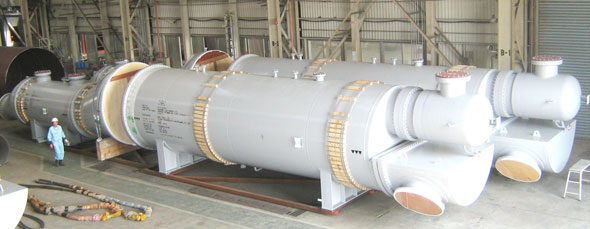Home > Press Releases > 2015 > Kobe Steel to supply vaporizers for LNG receiving terminal in Malta
Press Releases
The information on this Web site is presented "as is." Product availability, organization, and other content may differ from the time the information was originally posted. Changes may take place without notice.
![]()
 Kobe Steel to supply vaporizers for LNG receiving terminal in Malta
Kobe Steel to supply vaporizers for LNG receiving terminal in Malta
April 14, 2015
TOKYO, April 14, 2015 — Kobe Steel, Ltd. announces that its intermediate fluid LNG vaporizers (IFVs) will be used in the regasification facility for the Delimara LNG Regasification Terminal under construction in Malta. Kobe Steel will supply two IFVs. Each unit will have a regasification capacity of 58 tonnes per hour. Kobe Steel plans to ship the IFVs in October 2015.
Electrogas Malta Limited will operate the large-scale LNG receiving terminal upon completion. J&P-AVAX S.A., one of Greece’s largest construction groups, is undertaking the engineering and construction of the receiving terminal. A floating storage unit (FSU), to be moored offshore, will supply the LNG to the land-based receiving terminal, where the regasification facility will vaporize the LNG into natural gas. The natural gas will be supplied to the adjacent Delimara Power Station, Malta’s largest power generation facility, and the new combined cycle power plant to be build. Kobe Steel’s IFVs will be the main equipment installed at the regasification facility.
To increase the power generation capacity of the new combined cycle power plant cold energy derived from LNG regasification of Kobe Steel’s IFVs will be used in order to cool the air to the gas turbines.
At minus 160 degrees Celsius (-160 C), LNG becomes an extremely low-temperature fluid. During regasification, an enormous amount of cold energy is given off. In the past, this energy was merely discarded together with the exchange medium, such as seawater, after regasification. However in recent years, attention is focusing on the effective use of cold energy.
Kobe Steel’s IFVs are highly suitable to effectively make use of cold energy. The Japanese company’s cooperation with J&P-AVAX’s during the early stage of design also contributed to winning the order for the IFVs.
Since shipping its first IFV in 1980, Kobe Steel has supplied over 40 units worldwide. In the field of IFVs, Kobe Steel is regarded as the world’s top manufacturer. Kobe Steel is also a leading supplier of open rack LNG vaporizers (ORVs). Delivering over 200 units, Kobe Steel has one of the world’s largest market shares for ORVs.
With world demand for energy increasing, Kobe Steel anticipates that the need for LNG vaporizers in regasification facilities will continue to grow. Kobe Steel intends to expand sales of LNG vaporizers to meet this demand.
Background information
![]()
Intermediate fluid LNG vaporizer (IFV)
![]()
IFVs generally use seawater as the regasification heat source. Propane is used as the intermediate medium. IFVs contain titanium heat exchanger tubes, noted for their erosion and corrosion resistance. IFVs can also handle high contents of sand or heavy-metal ions in seawater. As a result, IFVs can make effective use of the LNG cold energy and are appropriate for floating storage and regasification units (FSRUs).
Floating storage unit (FSU)
![]()
FSUs are often old LNG carriers that have been converted into floating LNG storage facilities. Regasification facilities are commonly located nearby on land or on a pier. Regasification equipment installed on a floating vessel is known as an FSRU.
As FSUs float on the water away from habitats, it is easier to gain regulatory approval than land-based LNG storage facilities. Using converted LNG carriers also reduces construction costs and construction time. As a result, the construction of FSUs has been accelerating in recent years.
Gas turbine inlet air cooling system
![]()
This equipment cools the air that is fed to the gas turbine. In a gas turbine, compressed air is used to combust the natural gas. When the external air temperature rises, the intake air density is lower. As the air mass is lower, the power generation capacity is reduced. By cooling the intake air, the air mass increases and power generation capacity goes up.
The Malta LNG receiving terminal will make effective use of the cold energy from the IFVs. The heat exchange between the circulating medium and the LNG in the IFVs will regasify the LNG. At the same time, the cooled circulation medium will be sent to the power station and will cool the intake air for the gas turbines. The turbines will warm the circulation medium, which will once again be used in the IFVs for LNG regasification.
Open rack LNG vaporizer (ORV)
![]()
ORVs also use seawater as the regasification heat source. Seawater flows over heat transfer panels that contain aluminum-alloy heat transfer tubes, regasifying the LNG flowing in the tubes. The design is simple, the running cost is low, and a large amount of LNG can be regasified. Consequently, ORVs are commonly used in land-based LNG receiving terminals.

File photo of two IFV units for shipment to a receiving terminal in China


